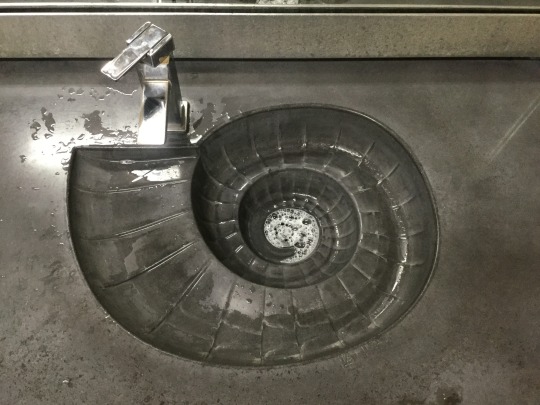#fossil
Explore tagged Tumblr posts
Text

Mia Bergeron (American, 1980) - Fossil (2024)
733 notes
·
View notes
Text

Behold the dazzling colors of an iridescent ammonite (Placenticeras intercalare)! A relative of today’s squids, this ammonite lived some 80 million years ago near what is now Alberta, Canada. This fossil’s spectacular coloration is the result of millions of years of high temperatures and pressures. As these forces acted on nacre in this ammonite’s shell, it was transformed into a gemstone known as an ammolite. Along with amber and pearl, ammolite is one of only a handful of gems made by living organisms.
You can spot this rare specimen in the Louis V. Gerstner, Jr. Collections Core in the Museum’s Richard Gilder Center for Science, Education, and Innovation! Plan your visit.
Photo: © AMNH
435 notes
·
View notes
Text
Actually all fossil reconstructions are wrong because flesh only evolved recently. Before that it was bone world
74K notes
·
View notes
Text
Kind of a beautiful image, especially considering bird's relation to dinosaurs.

From a project I was working on before going in another direction, but still wanted to post this. Inspired by this photo of mourning doves nesting in the fossil of a triceratops, and how it tells us that the world can end, just not forever.
9K notes
·
View notes
Text

Yes, this Hyphalosaurus fossil REALLY DOES exist, and it is on the cover of our new book, written by Dr Dean Lomax - Palaeontologist and illustrated by me (Published by Columbia University Press). Read all about it and 49 other amazing fossils (not all dinosaurs) that tell us about the behaviour of prehistoric animals. Pre-order on Amazon now!
#Fossil#FossilHunter#Fossils#Paleontology#Palaeontology#Paleontologist#NaturalWorld#Jurassic#Dinosaur#Geology#Nature#Ancient#JurassicPark#Prehistoric#Extinct#Animals#DinosaursOfInstagram#FossilHunting#DinosaurBook#DinosaurArt#Art#Painting#PaleoArt#PalaeoArt#SciArt#SciComm#DigitalArt#Illustration#Dinosaurs#Birds
184 notes
·
View notes
Text

let's be fossilized with mama
(cr. geosciences jorunal)
70 notes
·
View notes
Text

together forever :)
what if we were little bugs holding hands encased in amber forever and ever :))))
prints available here :p
#theyre best friends for eternity!#my art#digital art#art#illustration#amber#bugs#fossil#body fossil
32K notes
·
View notes
Photo
Paleontology fun fact
"Crocodilus robustus", here shown as the more robust animal on the left of the image, is not an extant animal as the illustration might suggest. Instead this animal is nowadays known by the name Voay and died out within the last two thousand years.
What the image also doesn't show is what Voay is arguably best known for these days, a pair of large squamosal horns that somewhat resemble ears (though they are bony structures located just above the ear flap). And if you think the one below looks funky, trust me, theres skulls with even more extreme horns.

Crocodilus madagascariensis meanwhile, our more gracile animal in the original post, is nowadays agreed to simply be a modern nile crocodile, who established a population on Madagascar. While it was at one point believed that they only moved in after the extinction of Voay, this no longer seems to be the case and the two appear to have overlapped. Fun fact, the name Crocodilus madagascariensis was actually coined twice by two different authors independent of each other. Another fun fact, some nile crocodile populations on Madagascar actually live in caves.

🐊 Histoire physique, naturelle, et politique de Madagascar Paris: Impr. nationale, 1885- Original source Image description: Detailed black and white lithographic illustration of two crocodile heads viewed from above. The left crocodile is labeled “2” and identified as Crocodilus robustus, showing a broad, textured snout with distinct scales and nostrils. The right crocodile, labeled “1” as Crocodilus madagascariensis, has a slightly narrower snout and prominent bony ridges. Both heads feature detailed skin textures with visible scales and symmetrical patterns. The print includes scientific labeling and is from an 1885 publication titled “Histoire physique, naturelle, et politique de Madagascar,” focusing on reptiles.
#croc#crocodile#voay#nile crocodile#madagascar#holocene#fossil#palaeoblr#prehistory#pseudosuchia#Crocodilia#crocodylus
173 notes
·
View notes
Text



Potamon sp. Crab Fossil; Pleistocene Epoch (2.58 - 0.012 MYA)
#fossil#fossils#crab fossil#prehistoric#collectible fossil#fossil collection#sea fossil#marine biology#marine fossil#special collections#collectibles#crystals#geology#rocks and minerals#stone aesthetic#paleontology#naturalhistory#evolutionarybiology#natural#natural history#natural life#marine animals#gemstones#sea creatures#sea life#marine life#sea animals
17K notes
·
View notes
Photo

Fossil sink
27K notes
·
View notes
Text

Fossil of dragonfly larva or I don’t know.
49K notes
·
View notes
Text
MY FAVORITE 🤩

It’s Fossil Friday, so soar into the weekend with Archaeopteryx! When this dinosaur was first described in 1861, it caused a sensation. Discovered shortly after Charles Darwin proposed the theory of evolution by means of natural selection, Archaeopteryx provided an example of evolution in action—a fossil that showed the transition between reptiles and birds. The first Archaeopteryx fossils ever found included exquisitely preserved skeletons with clear imprints of wings and feathers, but also teeth and a bony tail. Today, scientists think Archaeopteryx wasn’t able to fly very well, but the species still represents a turning point in paleontologists’ understanding of the relationship between ancient dinosaurs and modern birds in the design of both its body and brain.
Learn more about the fascinating world of dinosaurs at the Museum!
Photo: © AMNH
#natural history#nature#fossil#animals#museum#science#dinosaur#archaeopteryx#Is my favorite#Dinosaur#hope is the thing with feathers
2K notes
·
View notes
Text

Blather On 🦴
7K notes
·
View notes
Text

Opalised dinosaur femur. Registration no. P 208014.
4K notes
·
View notes
Text

go grandpa
9K notes
·
View notes